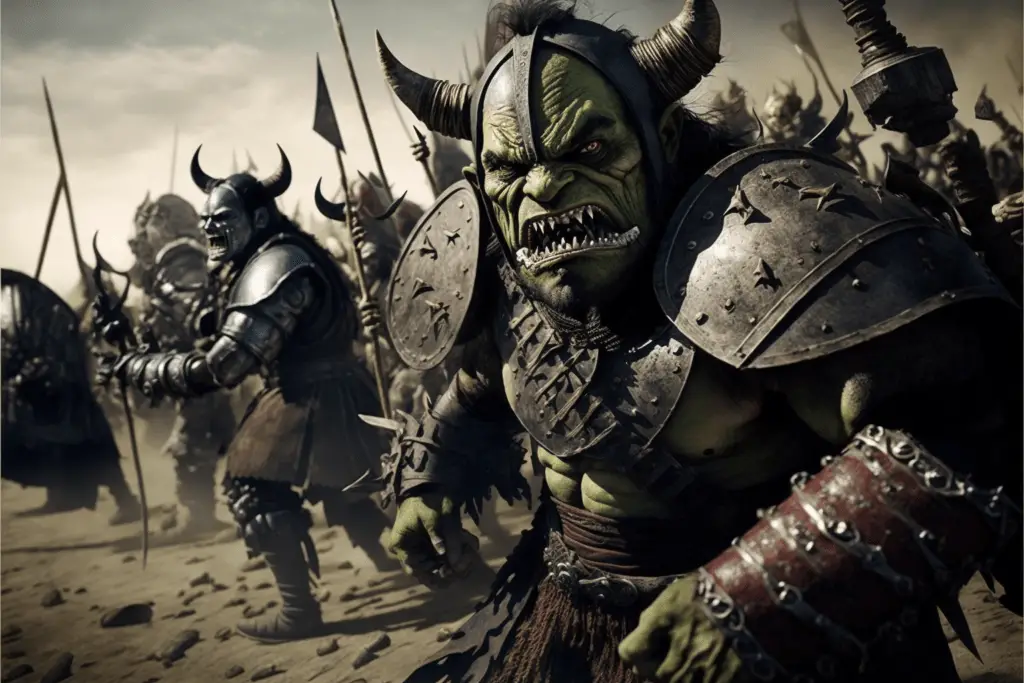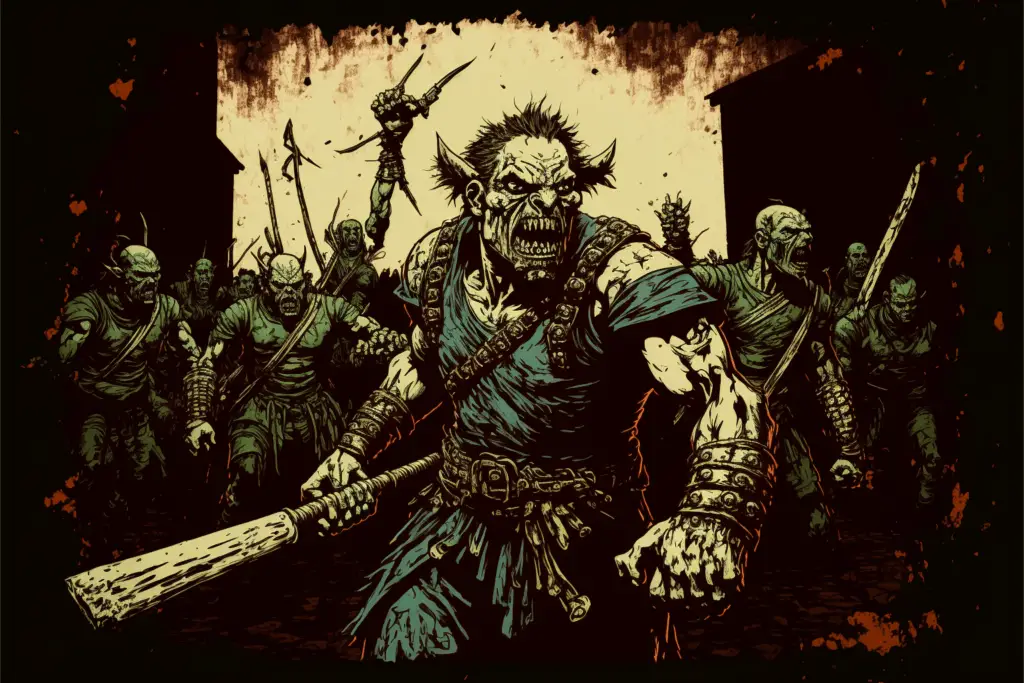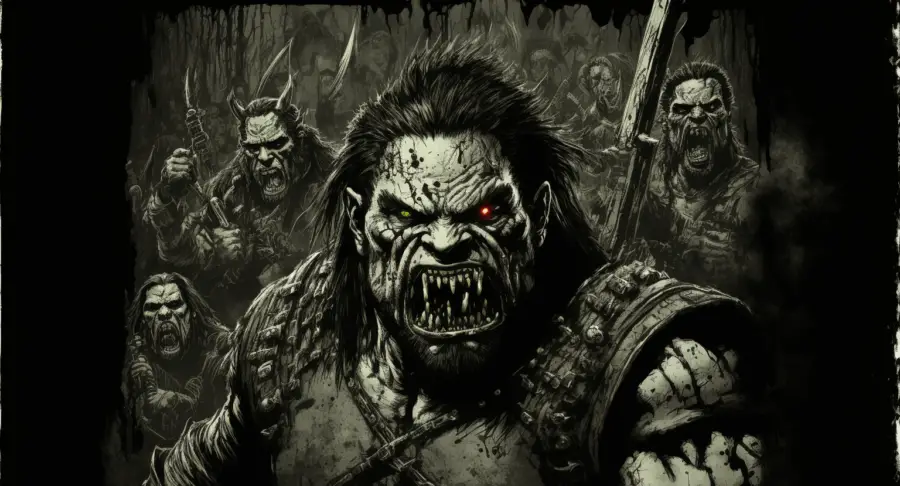Share the Lore!
By: Sid Meyers
What Is The Origin Of Orcs?
J.R.R. Tolkien’s Orcs were monsters that played significant roles in The Hobbit and The Lord of The Rings.
Orcs served as the henchmen of Sauron and Saruman or, as some would argue, their slaves. They formed the bulk of Mordor’s army and terrorized the landscape.
Tolkien’s Orcs often resembled ogres, with ties to humans, goblins, elves, and sorcery. But their description and origins shifted between Tolkien’s tales.
Nor was Tolkien the first to reference these fantastical creatures.

Beowulf: Main Inspiration For J.R.R. Tolkien’s Orcs
While Tolkien drew from various texts, Beowulf is the source of the main inspiration for his Orcs. Tolkien loved the tale and spent years trying to translate it, the results of which were published by his son posthumously.
In the Old English epic poem, the orcnēas (monsters) include Grendel, the main villain of the tale. The word comes from Orcus.
Orcus is known by many names for the same entity: Hades, Pluto, and Dis Pater.
However, Tolkien had a slightly different interpretation of the Old English word. While he refers to its usage in Beowulf, he breaks it down into its roots rather than its mythology.
Tolkien explains in Notes on Nomenclature that he took the word “orc” from Old English: “[Beowulf 112 orc-nass and the gloss orc = pyrs (‘ogre’), heldeofol (‘hell-devil’)].”
Thus, for Tolkien, these Orcs have a closer relationship to a demon than a god of the underworld.
Tolkien’s Orcs Were Originally Orks
Tolkien’s Orcs were originally to be Orks, as he explains in his Notes on Nomenclature. But he was inconsistent in the manuscript, and the spelling of “Orc” dominated. Thus, in a time well before “find and replace,” Tolkien gave up and left them as Orcs in the tales.
The Hobbit Orcs Are Goblins By Mistake (Mostly)
In The Hobbit, Orcs are goblins. However, this appears to be an error, and once that left Tolkien greatly displeased.
“Orc. This is supposed to be the Common Speech name of these creatures at that time,” Tolkien insists in Notes on Nomenclature. “[However, it] was translated ‘goblin’ in The Hobbit.”
In the book, these goblin-Orcs are modeled after goblin lore found in George MacDonald’s The Princess and the Goblin. It is a fairy tale where a ring turns the princess invisible, and she escapes the goblins.
Thus, while the word “goblin” may have been in error, there is a great deal of commonality with fairy tale goblins, including being fearful of the sun and weakened by it.
The Book Of Lost Tales Has Orcs Made From Mud
Tolkien’s goblin-Orcs first appeared in early stories that make up The Book of Lost Tales (and volume 2). While these stories were published posthumously, there is one that provides an origin story for the Orcs, where the Morgoth uses sorcery to create them from heat and mud.

The Lord of the Rings Orcs Can Face Daylight
Tolkien’s Orcs in The Lord of the Rings are diverse and no longer resemble the classic goblin. However, their “goblin” like history is routinely referred to through the books.
But unlike the old goblin-Orcs, these creatures are huge, strong, and can easily venture into the daylight. There is also a suggestion they might feast on their dead.
The origins of Orcs in the trilogy are not confirmed. It isn’t until The Silmarillion the origins of Orcs are addressed. But even so, there are different ages and “breeds” of Orcs. Thus, there is great debate if The Silmarillion Orcs are directly related to any featured in The Lord of the Rings.
However, the trilogy does mention that Saruman’s Orcs are “goblin-men,” where Orcs and humans have been bred, presumably by force.
Orcs in these stories have different languages depending on where they hail. For example, there is Common Speech, used to converse between separate groups; Black Speech, used by the Orcs from Mordor; and Orcs that are from Isengard have other languages.
The Silmarillion Orcs Are Enslaved Elves
In The Silmarillion, Melkor’s Orcs have an origin story, which may link to the Orcs in The Lord of the Rings.
Melkor (who becomes known as Morgoth) creates the Orcs by capturing Elves from the East. The Elves are enslaved, tortured, twisted, and corrupted to create the hideous monsters that carry out his bidding.
Charles Kingsley Mentions Orcs Before Tolkien
Tolkien was not the first writer to refer to Orcs after Beowulf. For example, Charles Kinsley, a writer, and Anglican clergyman wrote two books in the mid-1860s that mention orcs:
- The Water-Babies (1863)
- Hereward the Wake (1865/6)
In The Water-Babies, the orcs appear in chapter five in a list of terrifying mythical creatures a professor is forced to imagine after he refuses to accept the water-babies that an old fairy showed him:
“So she took the poor professor in hand: and because he was not content with things as they are, she filled his head with things as they are not, to try if he would like them better; and because he did not choose to believe…griffins, phoenixes, rocs, orcs…”
In Hereward the Wake, the orcs are again a part of a list. However, this time they are creatures that Hereward believes lurk beyond Bruneswald, which was the center of his worldview.
“[B]ut beyond, things unspeakable, – dragons, giants, rocs, orcs, which-whales, griffins, chimeras, satyrs, enchanters, Paynims…”
Charles Kingsley’s Orcs Might Be Sea Orcs
While Kingsley did, indeed, mention Orcs even before Tolkien was born (1892), Kingsley does not describe them or provide an origin story.
Thus, Kingsley’s Orcs may not bear any resemblance to Tolkien’s or the monster in Beowulf, but they could be like the one found in Ludovico Ariosto’s epic poem, Orlando Furioso.
The poem is not a comedy, despite the fact that this fifth canto has been cited as the inspiration for Much To Do About Nothing. Instead, it is a story where women characters are treated horrendously.
The portion of the tale that contains the orc begins with Proteus raping the daughter of the King of Ebuda. The girl becomes pregnant.
The king, in his fury, kills his pregnant daughter, which enrages Proteus.
Thus, Proteus demands the kingdom provide beautiful unmarried women to feed his orc, a ferocious sea monster.
Ariosto’s use of orc in this manner was common. So much so, Tolkien is at pains to point out in his Notes on Nomenclature that his Orcs were not “to be connected with modern English…applied to various sea-beasts of the dolphin order.”

Are There Women Orcs?
Tolkien’s stories never directly reference a woman orc. However, the origin story of The Silmarillion Orcs suggests women Elves were involved in their creation, at least at the start.
In addition, the “goblin-men” bred by Saruman imply human women were involved, although Tolkien spares readers of the vivid details.
It is a question Tolkien pondered, musing in a letter back in 1963, “there must have been orc-women.”
Modern “revisionist” orc tales frequently feature women Orcs. These stories typically portray Orcs as complex characters with culture and values and are a far cry from inherently evil.
Are Orcs Evil?
The question of Orcs being inherently evil is one Tolkien fans debate to great lengths. But many theorize that Tolkien wrestled with the question too, and is why the Orcs have so many origin stories in his work.
Tolkien took great pains to hammer out his fantastical world, the languages, and their history. However, in the case of the Orcs, he never seemed satisfied.
In the simpler versions, the Orcs are molded shells of mud, nothing more than a soccer’s bidding. They are instruments of evil and lack depth and nuance.
But in their most complex versions, the Orcs are creatures molded out of unimaginable horrors; their goodness was driven out by unspeakable pain. It is an utterly terrifying concept, and perhaps one Tolkien felt was too horrible for his more hopeful tales.
Resources:
- Orc: mythological creature
- Tolkien was right: Scholars conclude Beowulf likely the work of a single author
- JRR Tolkien’s translation of Beowulf: bring on the monsters
- The Tolkien Society: Timeline
- Orlando Furioso: The orc’s vile appetite, and skewered Frisians

